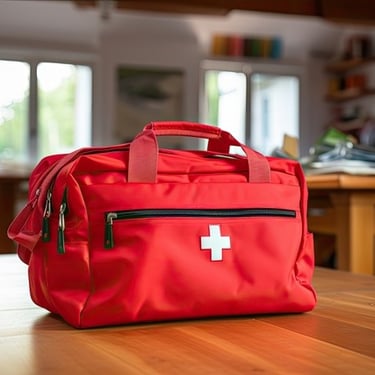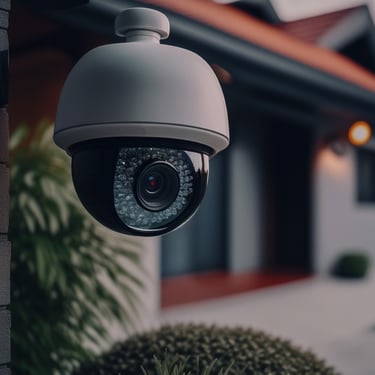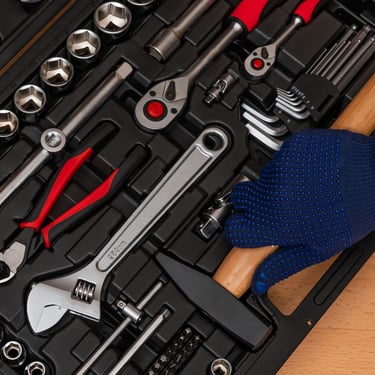PREPPING INSIDE YOUR HOME
Your home is your safest place during an emergency—if you’re prepared. By setting up food and water storage, improving security, and having essential supplies ready, you can face any situation with confidence. Let’s break down the simple steps to make your home ready for anything.




1. Creating a Food and Water Storage Plan
Why It Matters
During emergencies, grocery stores can run out of essential supplies fast, and water sources may become unreliable. Having a well-thought-out food and water storage plan ensures that your family stays nourished and hydrated when disaster strikes.
Food Storage Plan: What to Store and How
Start Small & Build Up – Aim for a 3-day supply per person as a minimum, then gradually increase to at least two weeks' worth. In extended emergencies, having a 30-day food supply is ideal.
Choose Non-Perishable, Long-Shelf-Life Items – Stock up on foods that last long and require little or no cooking. Some good options include:
Canned proteins (tuna, chicken, beans)
Dried foods (rice, pasta, lentils, oats)
Nut butters & seeds (peanut butter, almond butter, sunflower seeds)
Freeze-dried or dehydrated meals (great for compact storage)
Shelf-stable dairy (powdered milk, canned evaporated milk)
Include Comfort & Nutrient-Rich Foods – During stressful times, familiar foods can boost morale. Consider:
Dried fruit, nuts, and trail mix for quick energy
Granola bars & protein bars for easy snacking
Instant coffee, tea, or electrolyte powders
Don’t Forget Pets! – Ensure you have at least two weeks' worth of pet food and extra water for them. Read more about prepping for pets.
Store Food Properly – Use airtight containers to prevent moisture and pests. Keep supplies in a cool, dark, and dry place. Learn More.
Recommended: Stock up on an Emergency Food Supply Kit (30-Day) with a long shelf life for easy meal preparation.
Water Storage Plan: How Much & How to Store It
Calculate Your Needs – Store at least 1 gallon of water per person per day (for drinking & hygiene). A family of four needs at least 12 gallons for a 3-day emergency. If space allows, aim for a 2-week supply (28 gallons for a family of four).
Best Storage Options – Choose containers designed for long-term water storage, such as:
Water bricks (stackable and space-efficient)
5-gallon BPA-free jugs (easy to carry and refill)
55-gallon water barrels (great for large storage, but requires a pump)
Keep Water Fresh – Rotate stored water every 6 months or treat it with water purification tablets or unscented bleach (1/8 teaspoon per gallon) to extend freshness.
Have Water Filtration & Purification Backup – If water supplies run low, a portable water filter or boiling can make collected water safe to drink. Learn more.
Recommended: This BPA-Free 5-Gallon Water Storage Container is durable, stackable, and great for emergencies.
Practice & Plan Ahead
Use your stored food occasionally to check expiration dates and ensure your family likes it.
Replenish stock regularly so nothing goes to waste.
Keep a manual can opener with your emergency supplies.
By preparing now, you'll have peace of mind knowing you and your family can stay safe, fed, and hydrated in any crisis.
2. Improve Home Security: Protecting Your Home & Family
Why It Matters
Emergencies come in many forms—whether it’s burglary, hurricanes, earthquakes, wildfires, or power outages, your home must be a safe and secure place for you and your family. Strengthening your home protects not just your belongings but also your life in extreme situations.
1. Securing Your Home Against Intruders
Reinforce Entry Points – Strengthen doors and windows to prevent break-ins:
Use 3-inch screws in door hinges and strike plates to resist forced entry.
Install a deadbolt reinforcement kit to prevent doors from being kicked in.
Use security film on windows to prevent easy shattering.
Secure Windows & Sliding Doors – These are common entry points for burglars:
Place dowels or rods in tracks to prevent doors from being pried open.
Add shatter-resistant privacy film to stop intruders from seeing inside.
Install window and sliding door locks for extra protection.
Create a “Safe Room” – Have a designated safe space in case of a home invasion:
Reinforce one interior room with a solid-core door & heavy-duty lock.
Keep emergency supplies, a charged phone, and self-defense tools inside.
Use Smart Security Systems – Modern security measures can help deter threats:
Motion-sensor lights around the house.
Security cameras (visible ones act as deterrents).
Monitored alarm systems for round-the-clock protection.
2. Protecting Your Home from Natural Disasters
Hurricane & Storm Preparedness
Hurricanes and severe storms bring strong winds, flooding, and flying debris. Protect your home by:
Installing hurricane shutters or impact-resistant windows to prevent glass from shattering.
Reinforcing garage doors with braces or storm-resistant materials.
Trimming trees & securing outdoor furniture to prevent damage from flying objects.
Sealing roof gaps & inspecting drainage systems to prevent leaks and water damage.
Stocking up on emergency supplies (non-perishable food, water, flashlight, batteries).
Earthquake Preparedness
Earthquakes can happen without warning, causing structural damage and injuries. Here’s how to prepare:
Secure heavy furniture & appliances – Bolt bookcases, TVs, and cabinets to the wall.
Install safety latches on kitchen cabinets to prevent items from falling.
Use flexible gas line connectors to reduce the risk of gas leaks.
Create an earthquake emergency plan – Know where to "Drop, Cover, and Hold On."
Recommended: Earthquake Safety Straps – Helps prevent furniture from toppling over.
Wildfire Protection
Homes near forested or dry areas are at risk of wildfires. Reduce risks with these steps:
Create a defensible space – Clear dry grass, leaves, and debris at least 30 feet around your home.
Use fire-resistant materials – Install metal roofing and use non-combustible siding.
Seal vents & install ember-resistant screens to prevent sparks from entering.
Have a wildfire evacuation plan – Know multiple escape routes and prepare a go-bag.
Keep a fire extinguisher & tools (shovels, rakes, hoses) ready for emergencies.
3. Additional tips
Store important documents, emergency cash, and valuables in a fireproof, waterproof safe.
Emergency Exit Plan: Every family member should know two ways to exit each room in case of fire, earthquake, or break-in.
Conduct home security drills and disaster response drills with your family.
Keep emergency contacts, local shelters, and escape routes written down.
By reinforcing your home against both burglary and natural disasters, you ensure your family's safety and survival in any crisis.
3. Assemble First Aid Kits
Why First Aid Matters
Even minor injuries can turn serious without proper treatment, especially during emergencies when medical services may be delayed or unavailable. A well-stocked first aid kit allows you to handle cuts, burns, fractures, and other medical situations immediately, preventing complications and ensuring safety.
Tip: Keep multiple first aid kits—one at home, in your car, and your emergency go-bags. Being prepared can make all the difference.
1. First Aid Essentials: What to Include
Trauma & Wound Care
Serious injuries need immediate attention. Equip your kit with supplies to stop bleeding and protect wounds:
Tourniquets – These are Essential for severe limb injuries to control heavy bleeding.
Recommended: Military-grade, easy-to-use tourniquet.
Hemostatic Clotting Agents – Rapidly control bleeding in deep wounds.
Recommended: QuikClot Gauze, infused with clotting agents.
Sterile Dressings & Bandages Prevent infection and promote healing..
Adhesive Bandages & Butterfly Stitches – For minor cuts and scrapes.
Recommended Trauma kit: Everlit Trauma Pak
Medications & Treatments
Stock essential over-the-counter medications for common health issues:
Pain & Fever Relief – Acetaminophen, ibuprofen, and aspirin.
Allergy & Antihistamines – Diphenhydramine (Benadryl) or loratadine for allergic reactions.
Stomach Relief – Antacids, anti-diarrheal meds (Immodium), and laxatives.
Electrolytes & Dehydration Treatment – Crucial for preventing dehydration.
Recommended: Liquid IV Electrolyte Powder for fast hydration.
Prescription Medications – Store a 7–30 day supply of daily medications in waterproof packaging.
Burn & Respiratory Care
Burn Gel & Dressings – Soothes and promotes healing.
Recommended: Burn Jel with lidocaine for pain relief.
CPR Mask & Gloves – Essential for safe resuscitation.
Instant Cold Packs – Helps with swelling and pain from sprains or fractures.
Emergency Medical Guides & Tools
First Aid Manual – A must-have guide for medical emergencies.
Recommended: American Red Cross First Aid Guide.
Medical Tweezers & Scissors – For splinter removal and cutting bandages.
Thermometer – Detect fever quickly.
Recommended: No-Touch Infrared Thermometer, fast and hygienic.
2. First Aid Kit Placement: Where to Keep Them
Home: Your main first aid kit should be fully stocked and in a central, easy-to-access location.
Car: A portable first aid kit is crucial for road trips, accidents, or getting stranded. Read more.
Bug-Out Bag: A lightweight survival medical kit for emergencies. Learn more.
Workplace: Having a kit in your office or job site ensures quick access to medical supplies. Read more.
3. Prepping for Medical Emergencies
Get Trained – Learn CPR, wound care, and basic first aid skills. Get more details.
Check Expiration Dates – Regularly replace expired medications and supplies.
Keep Emergency Contacts Handy – Include a medical information card in each kit.
Customize Kits – Adapt supplies based on your family’s needs, including children, elderly members, and pets.
4. Best First Aid Books for Emergencies
In addition to a well-stocked first aid kit, having a reliable first aid manual can provide crucial guidance during an emergency. Here are some of the best first aid books available:
The Complete First Aid Pocket Guide by John Furst – A step-by-step guide covering a wide range of medical emergencies, designed for easy reference.
ACEP First Aid Manual (5th Edition) – Endorsed by the American College of Emergency Physicians, offering comprehensive, step-by-step first aid instructions.
The Natural First Aid Handbook by Brigitte Mars – Focuses on household remedies, herbal treatments, and natural solutions for common ailments.
First Aid & Safety For Dummies by Charles Inlander – A beginner-friendly, comprehensive guide covering a wide range of first aid and safety topics.
The Pocket First-Aid Field Guide by George E. Dvorchak – A compact, portable guide ideal for outdoor enthusiasts and survival situations.
Having one of these manuals on hand ensures you're well-prepared to manage medical emergencies effectively.
5. Recommended First Aid Kits
Surviveware Large First Aid Kit – Comprehensive and well-organized, ideal for home use.
MyFAK First Aid Kit by My Medic – Tactical, rugged, and great for survival and outdoor use.
Mini First Aid Kit – Lightweight and waterproof, perfect for travel.
A well-stocked first aid kit can be life-saving in an emergency. Whether dealing with a disaster, power outage, or accident, having the right supplies and knowing how to use them is crucial.
4. Power and Light: Stay Prepared for Power Outages
Why Backup Power & Lighting Matter
Power outages can strike at any time due to storms, earthquakes, hurricanes, wildfires, or grid failures. When the electricity goes out, you could be left without heating, refrigeration, lighting, and communication. Reliable backup power and lighting solutions help you stay connected, warm, and safe during emergencies.
Tip: A well-prepared home should have multiple backup power sources, including solar, battery-powered, and manual options.
1. Essential Backup Power Solutions
Portable Generators
Portable generators are versatile devices that provide electricity during outages, capable of powering essential appliances and devices. They come in various fuel types, including gasoline, diesel, propane, and natural gas.
Gasoline Generators: Widely available and typically more affordable, but gasoline has a shorter shelf life and can be scarce during emergencies.
Diesel Generators: More fuel-efficient and durable, suitable for longer-term use, but usually heavier and may emit more pollutants.
Propane and Natural Gas Generators: Cleaner-burning fuels with longer shelf lives; however, they require fuel delivery and proper storage solutions.
Safety Tips for Using Portable Generators:
Placement: Always operate generators outdoors, at least 20 feet away from your home, with the exhaust directed away from windows and doors to prevent carbon monoxide poisoning.
Ventilation: Never use a generator in enclosed or partially enclosed spaces, as they can produce high levels of carbon monoxide rapidly.
Fuel Storage: Store fuel in properly labeled, non-glass safety containers, away from living areas and fuel-burning appliances.
Refueling: Turn off the generator and let it cool before refueling to prevent ignition of spilled fuel.
Electrical Connections: Plug appliances directly into the generator or use heavy-duty, outdoor-rated extension cords. Avoid connecting the generator directly to your home's wiring unless a qualified electrician has installed a transfer switch.
Top Portable Generator Picks:
Honda EU2200i Inverter Generator: Known for its reliability and quiet operation, suitable for powering small appliances and sensitive electronics.
Generac GP8000E: Offers a balance of power and portability, ideal for home backup needs.
Portable Power Stations
Portable power stations are rechargeable battery-powered units that provide electricity without the need for fuel, making them safe for indoor use.
Ideal for: Powering small appliances, medical devices, and multiple electronics simultaneously.
Rechargeable via: Solar panels, wall outlets, or car chargers.
Top Picks:
Jackery 500 Portable Power Station – Ideal for powering small appliances and medical devices during blackouts.
Jackery Explorer 3000 Power Station – Higher capacity, capable of charging multiple devices at once.
Solar Power Banks (For Phones & Small Devices)
Solar power banks provide a convenient way to keep phones, radios, and flashlights charged when traditional power sources are unavailable.
Ideal for charging smartphones, emergency radios, and small USB devices.
Useful for off-grid situations where no power source is available.
Can be charged via solar or USB for flexible use.
Recommended Options:
BLAVOR Solar Charger Power Bank – Wireless, waterproof, and offers multiple charging options.
Anker 26800mAh Battery Pack – High-capacity battery, stores enough power to charge phones multiple times.
2. Emergency Lighting Solutions
LED Lanterns & Flashlights
Reliable lighting is crucial during an emergency. LED lanterns and flashlights provide bright illumination and last for hours on a single charge or set of batteries.
Essential for both indoor and outdoor use.
Battery-powered and rechargeable options available.
Long-lasting and energy-efficient.
Top Picks:
Etekcity LED Lanterns (4-Pack) – Compact, ultra-bright, and provides up to 12 hours of light.
GearLight LED Tactical Flashlights – Water-resistant and durable for emergency situations.
Motion-Sensor & Solar Lights
Outdoor lighting is useful for security and navigation during a power outage. Solar-powered and motion-activated options ensure your property remains well-lit without relying on electricity.
Motion-activated floodlights deter intruders and improve visibility.
Solar-powered lights offer free, long-lasting illumination.
Recommended:
Aootek Solar Motion Sensor Lights (4-Pack) – Weatherproof, bright, and easy to install.
Final Tip: Power Up Before the Storm
A fully charged power bank and well-stocked emergency lighting can make all the difference in an outage. Being prepared means staying safe and comfortable, no matter the situation. Take action today so you're never left in the dark!
5. Tools and Gear: Be Ready for Repairs, Survival, and Emergencies
Why It Matters
During emergencies, power outages, structural damage, and limited access to stores can make everyday tasks challenging. Having the right tools and gear ensures you can stay safe, make necessary repairs, and maintain a functional living environment when disaster strikes.
Essential Tools & Gear: What to Have and Why
Start with the Basics – Every home should have a core set of tools to handle minor repairs and emergency situations. Start with these essentials:
Multi-tool (Leatherman or Gerber) – A compact tool with pliers, knives, screwdrivers, and more for various tasks.
Manual Can Opener – Essential for accessing stored canned foods when there’s no electricity.
Heavy-Duty Flashlights & Headlamps – Ensure you have reliable lighting. Headlamps allow for hands-free operation.
Battery-Powered or Hand-Crank Radio – Stay informed with weather updates and emergency broadcasts.
Duct Tape & Zip Ties – Quick fixes for leaks, broken items, and securing loose objects.
Work Gloves & Safety Goggles – Protect your hands and eyes during repairs or cleanup.
Recommended: Highly Rated Multi-Tool – Durable and versatile for emergency use.
Emergency Radios & Communication
NOAA Emergency Radio – Provides weather alerts and emergency updates.
Two-Way Radios (Walkie-Talkies) – Enables communication when cell networks fail.
CB or Ham Radio – Allows long-distance communication when other methods are unavailable.
Recommended: Best-Selling NOAA Emergency Radio – A reliable option for staying informed in emergencies.
Emergency Shelter & Protection
Emergency Tents & Tarps – Essential for temporary shelter if your home becomes uninhabitable.
Mylar Thermal Blankets – Helps retain body heat in extreme conditions.
Sleeping Bags (Rated for Cold Weather) – Ensures warmth and comfort if forced to stay outdoors.
Plastic Sheeting & Duct Tape – Useful for sealing windows and doors against contaminants.
Recommended: Emergency Tent – Compact and lightweight for emergency situations.
Emergency Repair & Home Maintenance Tools
Adjustable Wrench & Screwdriver Set – Essential for fixing broken furniture, appliances, and pipes.
Saw or Hatchet – Useful for cutting wood for heat or emergency construction.
Crowbar or Pry Bar – Can be used for opening jammed doors or clearing debris after a disaster.
Fire Extinguisher – Crucial for fire safety in case of electrical malfunctions or kitchen fires.
Plastic Sheeting & Tarps – Temporary window or roof repairs to keep your home secure and dry.
Recommended: Compact Emergency Tool Kit – Includes essential hand tools for home emergencies.
Backup Cooking & Heating Equipment
Portable Propane or Butane Stove – Ideal for cooking when the power is out.
Fuel Supply (Propane, Butane, or Firewood) – Keep extra fuel for heating and cooking needs.
Thermal Blankets & Sleeping Bags – Helps retain body heat in cold weather conditions.
Recommended: Portable Stove – A reliable backup for cooking meals during power outages.
Practice & Plan Ahead
Store tools in an easily accessible location.
Regularly check batteries and power sources to ensure they are functional.
Familiarize your family with the location and proper use of emergency tools.
Replenish supplies and replace worn-out gear as needed.
By preparing now, you’ll have the right tools and equipment to keep your home functional, safe, and secure during any crisis.
6. Sanitation and Hygiene: Stay Clean, Stay Healthy
Why Sanitation & Hygiene Matter in Emergencies
When disaster strikes, poor sanitation can quickly lead to infections, disease outbreaks, and contaminated living spaces. If plumbing systems fail or the water supply is cut off, maintaining cleanliness and properly disposing of waste becomes a survival priority. Having essential hygiene and sanitation supplies ensures you and your family stay healthy and comfortable, even under the worst conditions.
Tip: Plan for at least two weeks' worth of sanitation supplies in case of prolonged infrastructure failure.
1. Essential Emergency Sanitation Supplies
Portable Toilets & Waste Management
When traditional plumbing is unavailable due to power outages, flooding, or disaster, a portable toilet is invaluable for maintaining hygiene and preventing contamination.
Look for durable, easy-to-clean options with secure waste containment.
Choose models that include waste bags for quick and sanitary disposal.
Top Pick:
Camco Portable Travel Toilet – Flushable, leak-proof, and ideal for home or camping.
Emergency Waste Bags & Odor Control
Proper waste containment prevents the spread of disease and keeps living areas sanitary.
Use biodegradable bags for eco-friendly disposal.
Odor-neutralizing treatments help maintain hygiene in confined spaces.
Recommended Options:
Reliance Double Doodie Waste Bags – Seals odors, easy to dispose of.
2. Hygiene Supplies: Staying Clean Without Running Water
Maintaining personal hygiene is critical for preventing illness during emergencies when access to clean water is limited.
Essential Hygiene Items
Soap & Hand Sanitizer – Prevents bacteria and virus transmission.
Toothpaste & Toothbrushes – Dental hygiene is often overlooked in survival situations.
Feminine Hygiene Products – Stock up on tampons, pads, or reusable menstrual cups.
Baby Wipes & No-Rinse Cleansing Wipes – Ideal for full-body cleaning without water.
Best Choices:
Dude Wipes XXL – Extra-large, unscented body wipes for complete cleansing.
No-Rinse Body Wash – Effectively cleans skin without the need for water.
Waterless Hair Care
Keeping hair clean without running water helps prevent scalp irritation and discomfort.
Dry Shampoo – Absorbs oil and refreshes hair instantly.
Leave-In Conditioner – Keeps hair manageable and reduces dryness.
Recommended:
Batiste Dry Shampoo – Quick and effective hair refresh during emergencies.
3. Waste Disposal & Contamination Prevention
Trash Bags & Waste Control
Heavy-duty trash bags are essential for managing waste, preventing contamination, and waterproofing essential items.
Use for food scraps, human waste disposal, and general sanitation needs.
Can double as makeshift emergency ponchos or waterproof covers.
Best Choice:
Hefty Ultra Strong Trash Bags – Tear-resistant, odor-locking, and versatile.
Toilet Paper Alternatives
If toilet paper runs out, have backup options ready for personal hygiene.
Compressed Toilet Wipes – Expand with just a few drops of water.
Recommended:
Combat Wipes Outdoor – Biodegradable, compact, and skin-friendly.
4. Smart Sanitation & Hygiene Plan
Store sanitation supplies in waterproof bins to keep them clean and dry.
Rotate and check hygiene items every six months to prevent expiration.
Designate a “hygiene station” in your home or emergency shelter.
Have a plan for safe and discreet waste disposal in long-term scenarios.
Sanitation Saves Lives – Be Prepared!
A clean environment is essential for preventing illness in emergencies. Proper sanitation planning keeps you and your family safe, comfortable, and prepared for any situation. Take action today and stay sanitary to protect your health!
7. Entertainment & Mental Health: Staying Positive in a Crisis
Why It Matters
During prolonged emergencies, boredom, stress, and uncertainty can take a toll on mental health. Keeping morale high is just as essential as having food and water. Entertainment, creativity, and maintaining a routine help establish a sense of normalcy and emotional stability during difficult times.
Tip: Choose offline entertainment options that don’t rely on electricity or internet access to ensure continuous enjoyment.
1. Fun & Engaging Entertainment Ideas
Board Games, Card Games & Puzzles
Classic games provide a great way to pass the time, keep minds engaged, and encourage social interaction.
Ideal for all ages, from children to adults.
Helps sharpen cognitive skills and relieve stress.
Top Picks:
100 Classic Board Games Set – A compact set with a variety of fun games for the whole family.
Uno Card Game – Fast-paced, easy to learn, and entertaining for all ages.
The Ultimate Brain Games Book – Packed with crosswords, Sudoku, and puzzles to keep the mind active.
Books & Journaling
Reading and writing provide both an escape and an outlet for emotions.
Books inspire, educate, and entertain.
Journaling helps process emotions and track important events.
Recommended Reads:
The Prepper’s Survival Bible – Learn essential survival skills while passing the time.
Moleskine Classic Notebook – Perfect for journaling, creative writing, or keeping emergency notes.
The Power of Now – Helps reduce anxiety and cultivate a calm mindset.
Offline Digital Entertainment
Download media in advance to ensure access to movies, audiobooks, and music even without an internet connection.
Portable music players and e-readers provide hours of entertainment.
Audiobooks and podcasts can be downloaded for on-demand enjoyment.
2. Managing Stress & Mental Health in Emergencies
Mindfulness & Relaxation Activities
Deep breathing, yoga, and guided meditation are powerful tools for reducing stress and improving focus.
Simple mindfulness exercises promote relaxation.
Adult coloring books provide a creative and calming distraction.
Recommended Item:
Calm the Chaos Adult Coloring Book – Designed to ease stress and anxiety.
Creative & DIY Activities
Engaging in hands-on activities can be therapeutic and help maintain a sense of accomplishment.
Drawing, knitting, and crafting serve as productive outlets.
DIY projects offer a fun way to stay engaged during downtime.
Top Picks:
Beginner’s Sketching Set – Includes pencils, a sketchpad, and guides for drawing.
DIY Candle-Making Kit – A relaxing and functional indoor activity.
3. Smart Planning for Mental Well-Being
Create a routine – Establishing daily habits brings structure and control to uncertain situations.
Encourage social interaction – Play games, share stories, or write letters to loved ones.
Limit news exposure – Too much negative information can increase anxiety and stress levels.
Next Steps: Build Your Home’s Resilience Today!
The best way to prepare is by tackling one category at a time. Start today by assembling your entertainment and mental health kit.
Disclaimer:
This site contains affiliate links to Amazon. As an Amazon Associate, I may earn a commission from qualifying purchases. Your support helps keep the site running, with no extra charge to you.
The information provided on this website is for general informational purposes only. While we strive to ensure accuracy and reliability, the content is not intended as professional advice. Always consult with qualified professionals for specific needs or situations.
